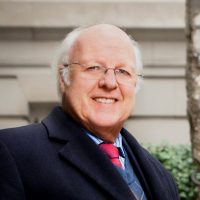Managing Global Migration

Jackson Janes
President Emeritus of AGI
Jackson Janes is the President Emeritus of the American-German Institute at the Johns Hopkins University in Washington, DC, where he has been affiliated since 1989.
Dr. Janes has been engaged in German-American affairs in numerous capacities over many years. He has studied and taught in German universities in Freiburg, Giessen and Tübingen. He was the Director of the German-American Institute in Tübingen (1977-1980) and then directed the European office of The German Marshall Fund of the United States in Bonn (1980-1985). Before joining AICGS, he served as Director of Program Development at the University Center for International Studies at the University of Pittsburgh (1986-1988). He was also Chair of the German Speaking Areas in Europe Program at the Foreign Service Institute in Washington, DC, from 1999-2000 and is Honorary President of the International Association for the Study of German Politics .
Dr. Janes is a member of the Council on Foreign Relations, the International Institute for Strategic Studies, the Atlantic Council of the United States, and American Purpose. He serves on the advisory boards of the Berlin office of the American Jewish Committee, and the Beirat der Zeitschrift für Außen- und Sicherheitspolitik (ZfAS). He serves on the Selection Committee for the Bundeskanzler Fellowships for the Alexander von Humboldt Foundation.
Dr. Janes has lectured throughout Europe and the United States and has published extensively on issues dealing with Germany, German-American relations, and transatlantic affairs. In addition to regular commentary given to European and American news radio, he has appeared on CBS, CNN, C-SPAN, PBS, CBC, and is a frequent commentator on German television. Dr. Janes is listed in Who’s Who in America and Who’s Who in Education.
In 2005, Dr. Janes was awarded the Officer’s Cross of the Order of Merit of the Federal Republic of Germany, Germany’s highest civilian award.
Education:
Ph.D., International Relations, Claremont Graduate School, Claremont, California
M.A., Divinity School, University of Chicago
B.A., Sociology, Colgate University
Expertise:
Transatlantic relations, German-American relations, domestic German politics, German-EU relations, transatlantic affairs.
__
Seventy years ago, one of the largest movements of refugees in European history was taking place following the capitulation of Germany and the end of war on the continent. Europe is now on a path to see a similar social, political, and cultural earthquake.
As the war was ending in 1945, millions had fled their homes or been expelled from eastern and central Europe into postwar Germany and Austria. Millions more were to be expelled, displaced, and resettled all over Europe, as the map of the continent became increasingly frozen by the Cold War.
Today’s movement is taking place not along an East-West plane, but along more of a North- South divide. While the current flow of immigrants and asylum seekers is part of a longer trend, it is sparking new problems in a Europe that is attempting to find a balance between what it stands for and what it is confronted by.
Principles vs. Populism
As Roger Cohen recently wrote, “A near borderless Europe at peace constitutes the great achievement of the second half of the 20th century. That you can go from Germany to Poland across a frontier near effaced and scarcely imagine the millions slaughtered seven decades ago is testament to the accomplishment. The European Union is the dullest miracle on earth.”
But today the European Union faces a moral dilemma. The dramatic increase of refugees is bringing Europe into conflict with its commitment to the principle of human rights and has contributed to a backlash in many member states where an older slogan, “the boat is full,” can be heard.
During the past quarter-century, waves of refugees and asylum seekers in Europe have been driven by the conflicts in the Balkans. More recently, it is those from the Middle East and Africa seeking entrance, as dramatically pictured in the overloaded boats attempting to cross the Mediterranean from Libya, Syria, and elsewhere and in the tales of those fighting to cross under the English Channel on trains and trucks or by foot.
In Germany last year, close to a quarter of a million people hoped to find asylum somewhere in the Federal Republic. This year more have already arrived, with many more thousands expected to follow. The backlash in Germany aimed at the rising number of asylum seekers is also significant. Attacks on shelters for these seekers have increased, as have right-wing activist protests.
Last year, the number of asylum seekers in Germany rose by 76 percent, compared with the same time period the previous year. Increased attention is being paid to the issue in German states as well, which, together with local communities, are responsible for providing accommodations for refugees. State officials are worried that their situations will worsen if the numbers continue to rise.
The refugee problem reminds us again that the EU remains in many ways a union of national interests. It lacks the tools to deal with this crisis and the money needed to address the problems is far greater than what has been spent so far.
With a wave of right-wing parties across Europe mixing euro bashing, double-digit unemployment, and fear, the wind seems to be picking up for immigration opponents. In Germany, the Alternative for Germany (AFD) is among those calling for a stop to more asylum seekers and immigrants. And more than a few voices in the Bundestag are also expressing their concerns with tough talk on refugees and related policies. Demonstrations organized by right-wing groups such as The Third Way and Pegida are gaining traction in some areas of Germany, even as they are met by counter demonstrations against them.
But the danger is that no one has a real solution to this challenge. It is a similar juggernaut as the illegal immigration problem in the United States with a good deal of shouting but not a lot of solutions.
The Quest for Opportunity
So is the boat full? Is a continent of some 500 million EU citizens unable to absorb this new wave of immigrants and asylum seekers? And who is to determine what, when, and how a “full boat” emerges?
Whether it is on the Mexican border or the shores of the Mediterranean, building military fortresses, walls, and surveillance systems will not ultimately resolve a migration problem—no matter how much populist politicians proclaim it. There is no moat surrounding Europe or defining the U.S.-Mexican border over which to raise a drawbridge. In fact, borders are becoming increasingly fluid and transparent amid the push and pull of people seeking survival—not only immigrants and asylum seekers. In fact, we are all on the same “global boat” and we all have a stake in keeping it afloat.
On both sides of the Atlantic, there is a challenge to develop a common policy that would find a path for those seeking the same high standard of living that Europeans and North Americans enjoy. That does not mean that millions of refugees from Africa and the Middle East will want or be able to pursue that goal in Europe any more than millions more from Mexico or Central and South America will move to the United States or Canada. The reality is that most people are not willing to risk their lives to leave their homes for another country or continent unless they are driven by fear of death or desperation. A smaller number of people are willing to risk an uncertain future in another country or region with the promise of more opportunities. It is part of the narrative in most countries around the world. And each of those countries has been changed by the ebb and flow of migration.
Among those countries, from which the current wave of refugees is fleeing, the common thread is the lack of opportunity. It is the lack of a future and existential danger that has driven two million Syrians to Turkey to save their lives from a horrific civil war, with another million fleeing over the border to Jordan. Those fleeing the same horrors in other countries, such as Libya, will not be persuaded to stop their desperate treks across the Mediterranean or through the other routes unless they have reasons not to fear where they are.
Today, Germany and the United States are the top two destinations for immigrants. There are reasons for that, which goes beyond the desire for wealth. These are countries that offer the opportunity to live a safe and secure life. Both countries have always been immigration countries, although Germany tried to deny it for several decades and there are those in the United States who wish to forget that legacy today.
Yet the fact is that the United States settles more refugees than any other country. And today Germany has stood out in its efforts to deal with the current wave of migrants and asylum seekers arriving at its borders in comparison with its European partners. While both countries have their share of those who declare that there is no more room on their boats, it is not a question of number so much as it is a perception of threat to the status quo, which feeds this backlash.
We have seen this before. The United States has had waves of anti-immigrant movements and policies throughout almost its entire history, driven by perceptions of invasion of too many immigrants from northern Europe (Ireland), followed by southern Europe (Italy), then eastern Europe, China, and Japan. Today, the perception is that there are too many people from south of the U.S. border.
We have seen a similar story in Europe over centuries, and it has resulted in battles between nations and ethic groups seeking to seal themselves off, occupy each other, or even eliminate what appears to be alien—as was so horrific in targeting the Jews. We also saw that evil reappear in the Balkans in more recent years and in today’s version of the Islamic State in Iraq and Syria.
Building a Community
After the Second World War, Europeans took a new path toward preventing the disaster they had just experienced by building a community of nations. That community is now made up of twenty-eight members, with more seeking to join. That community is a broad and deep mosaic of many different histories and beliefs, which have combined in the name of a larger mission. As Roger Cohen put it, today’s Europe is a miracle. There is a similar miracle in the evolution of the United States, which has also combined an enormous mixture of narratives to generate a common one for many millions of its citizens.
That process in Europe and in the United States continues today. We would not be who we are without the constant expansion of our contours—political, economic, social, and cultural.
It is that process which acts as a magnet for many others from other parts of the world. And we can be enriched by it. That very process has also enabled us to enrich other parts of the world so that the wealth, both politically and economically, can be shared in securing stability and opportunity for 7 billion inhabitants—who all live on the same boat.
But meanwhile, the current crisis requires that we stem the bleeding. The flight of refugees will not abate until the turmoil driving them is ended. Europe and the United States need to use resources not only to build walls, but also to build bridges. That cannot be done with ad hoc approaches in every member state. This is as serious a challenge as it was seven decades ago. But now it is global.









